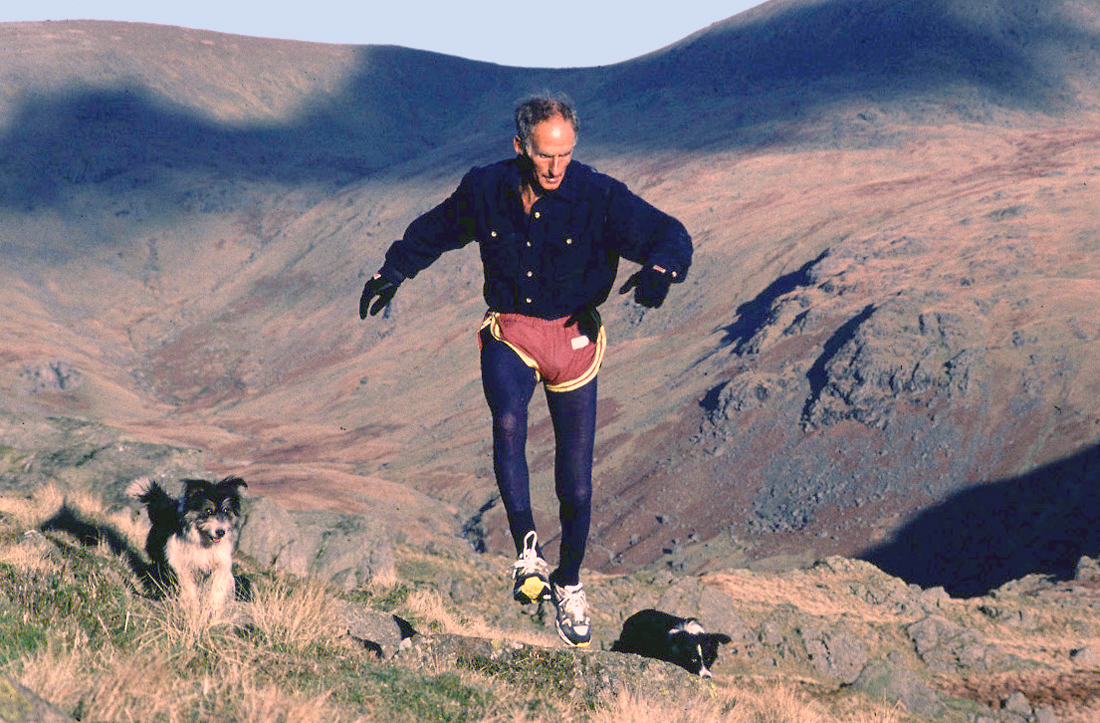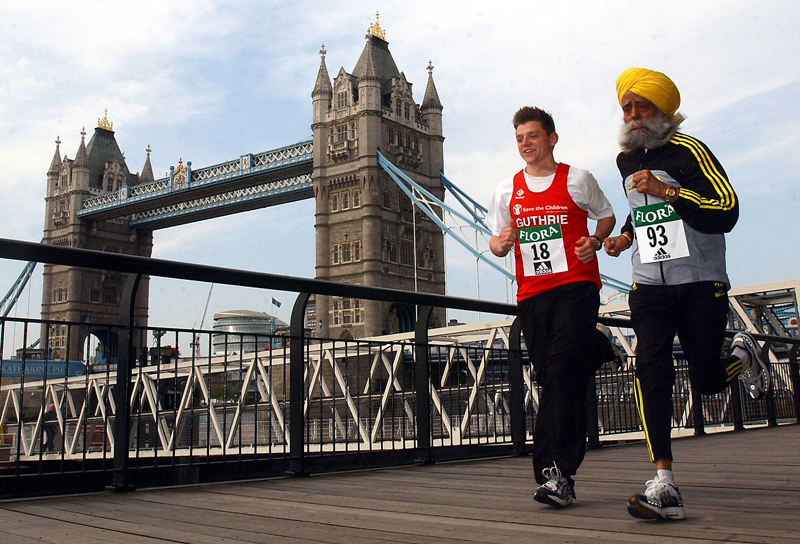Veteran endurance athletes: can ageing be beaten?
Professor Craig Sharp explores whether ageing is inevitable - or simply the result of ’detraining’?
A leading question to ask senior citizens, or those nearing seniority, is: ‘how old would you think you were if you didn’t know how old you are?’ I would predict that the disparity between theory and fact in the answer would give an indication of that person’s exercise level. No one can escape their genetic programme, but most people can do a great deal, barring injury and illness, to minimise some of the physiological aspects of ageing by means of modest exercise programmes which embrace conditioning in strength and flexibility as well as aerobic exercise.
It is worth noting that, from the 100m to the marathon, men and women of 80 take only up to 55% and 110% respectively longer than they did at 40, with a virtual plateau in performance between 20 and 35-40 (see table 1 below). The current gap between men and women will undoubtedly narrow with time, as women’s times are coming down faster than men’s.
This article will focus on the achievements of older distance runners, including veteran and masters athletes, together with changes in some of the physiological parameters relating especially to distance running in older people.
In 1900 people were considered old in their 40s; just 40 years ago people seemed old in their 60s; but today many do not feel old in their 80s – a phenomenon described as ‘youth creep’. Yet there is no common experience in the ageing process, for while an orchestra conductor might see himself as a mere stripling at 50, a 20-year-old rhythmic gymnast can feel hopelessly middle-aged.
The oldest Olympic medallist (silver) was Swedish rifleman Oscar Swahn, at 72 in 1920. He was also picked for the 1924 Paris Games, but had to drop out due to injury, and had previously won gold in 1912. The oldest British competitor was dressage expert Hilda Johnstone, aged 70 at the Munich Olympics. At least six Olympians have spanned 40 years, three yachtsmen, two fencers and one equestrian.
Turning to running, in 1994 41-year-old Eamon Coughlan ran the mile in 3:58:15, while 42-year-old Yekaterina Podkopayeva just beat 38-year-old Mary Decker in the 1997 world indoor 1500m final, and later ran 3:59:10. In the marathon, Carlos Lopez won the Los Angeles event in an Olympic record of 2:09:21 at age 38, having broken the world 10,000m record at 37, running 27:17:48. A 90-year-old man has run 4:25.27 and an 80-year-old woman 5:10:04.
At 80, men and women can run 100m in 14.35 and 18.0 respectively and 10k in under 45 and 59 minutes; and in all distances, from 100m to 10,000m, the general decline with age in trained men and women is linear and very gradual until 80, when times become less consistent (1,2). Until then, the rate of slowing-up is about 1-2% per year, about the same as the loss of maximum heart rate over the same period.
What are the key physiological changes impacting on performance with age? Body fat composition, which at 20 stands at about 12-16% in men and 23-28% in women, rises steadily to some 19-26% and 28-38% respectively by age 60-70, while lean body mass declines. Height tends to decrease by about 1cm per decade after age 40.
The ‘rete pegs’, which anchor the outer layer of skin – the epidermis – to the dermis beneath, shorten with age, making older runners increasingly susceptible to blister formation and skin trauma. Melanocytes, the skin cells producing melanin, diminish at a rate of some 2% annually in the 40s, and the cutaneous inflammatory response diminishes. Hence older athletes (especially novices) are more susceptible to sunburn than the young but do not show its acute effects as promptly.
| Age | Male | Female | Age | Male | Female |
|---|---|---|---|---|---|
| 4 | 6:03 | – | 49 | 2:33 | 2:51 |
| 5 | 5:25 | 4:56:30 | 50 | 2:25:42 | 2:50 |
| 6 | 4:07 | 4:00:30 | 51 | 2:29 | 2:52 |
| 7 | 4:04 | 3:52 | 52 | 2:25 | 3:01 |
| 8 | 3:37 | 3:13:30 | 53 | 2:31 | 3:00 |
| 9 | 3:07 | 3:11 | 54 | 2:32 | 2:52 |
| 10 | 3:02 | 3:07 | 55 | 2:34 | 2:52 |
| 11 | 2:47 | 3:04 | 56 | 2:39 | 3:07 |
| 12 | 2:46:30 | 2:58 | 57 | 2:38 | 3:13 |
| 13 | 2:43 | 2:53 | 58 | 2:38 | 3:21 |
| 14 | 2:41:30 2:51 | 59 | 2:48 | 3:24 | |
| 15 | 2:29 | 2:46:30 | 60 | 2:47 | 3:15 |
| 16 | 2:23 | 2:34 | 61 | 2:43 | 3:28 |
| 17 | 2:24 | 2:47 | 62 | 2:49 | 3:31 |
| 18 | 2:17 | 2:42 | 63 | 2:48 | 3:30 |
| 19 | 2:15 | 2:34:42 | 64 | 2:43 | 3:39 |
| 20 | 2:13 | 2:30:18 | 65 | 2:51 | 3:37 |
| 23 | 2:08 | 2:30:10 | 66 | 2:43 | 3:49 |
| 25 | 2:09:18 2:26:00 | 67 | 2:55 | 4:02 | |
| 26 | 2:11 | 2:29 | 68 | 2:52 | 4:03 |
| 27 | 2:08:40 2:28 | 69 | 3:01 | 4:01 | |
| 28 | 2:10:40 | 2:21 | 70 | 3:01 | 4:09 |
| 29 | 2:10 | 2:31 | 71 | 3:01 | 4:25 |
| 30 | 2:10 | 2:28 | 72 | 3:09 | 4:38 |
| 31 | 2:09:30 | 2:30 | 73 | 3:13 | 4:57 |
| 32 | 2:11:30 | 2:30 | 74 | 3:37 | 4:48 |
| 33 | 2:11:30 2:28 | 75 | 3:18 | 4:32 | |
| 34 | 2:13:12 | 2:30 | 76 | 3:35 | 4:31 |
| 35 | 2:12 | 2:32 | 77 | 3:33 | 5:13 |
| 36 | 2:15:30 | 2:36 | 78 | 3:37 | 5:01 |
| 37 | 2:12:42 | 2:28 | 79 | 3:49 | 5:04 |
| 38 | 2:17:18 | 2:27 | 80 | 4:28 | 5:10 |
| 39 | 2:14:18 | 2:31 | 81 | 4:50 | 5:51 |
| 40 | 2:17 | 2:40:30 | 82 | 4:38 | 6:14 |
| 41 | 2:19:18 | 2:38 | 83 | 5:20 | 6:33 |
| 42 | 2:20 | 2:42 | 84 | 4:18 | 6:02 |
| 43 | 2:23 | 2:40 | 85 | 5:22 | 6:54 |
| 44 | 2:25 | 2:35 | 86 | 5:40 | 7:57 |
| 45 | 2:26 | 2:45 | 87 | 6:49 | 7:09 |
| 46 | 2:26 | 2:53 | 88 | 6:52 | 8:03 |
| 47 | 2:27 | 2:52 | 89 | 6:36 | 8:09 |
| 48 | 2:31 | 2:51 | 90 | 7:53 | 10:13 |
The ageing heart and lungs
As far as the cardiorespiratory system is concerned, forced vital capacity decreases by about 250ml per decade. The elasticity of the pulmonary support structures diminishes, and the size of the alveoli (air sacs) increases, which can boost the work of breathing from 10% of the energy cost of exercise in the 20s to up to 20% in the 60s. The number of pulmonary capillaries declines, as does perfusion quality, and the respiratory centre becomes increasingly sensitive to blood levels of carbon dioxide. Thus ventilation increases disproportionately to oxygen intake in older subjects – ie they need to breathe in more air to get the same amount of oxygen.
Maximum heart rate declines by some 40 beats per minute between 20 and 60, while an age-related increase in the size of the myocardium (heart muscle) leads to a diminishing stroke volume by decreasing the size of the ventricular chamber. These changes contribute to a decline in VO2max of about 5ml.kg-1.min-1 per decade in untrained men and women(3). For those who remain in training, VO2max may remain consistently higher than in the untrained, eg by 20ml.kg-1.min-1 at age 40 and 10ml.kg-1.min-1 at 70.
Skeletal muscle capillarisation has been found to be as high in older runners as in younger ones of equivalent performance (4). Ageing muscle has been shown by some workers to contain higher percentages of type 1 fibres, which would appear potentially beneficial to elderly marathon runners (5). With age, muscle protein diminishes, as does the size and number of mitochondria (the site of the cell’s energy production), although this is less true if relative habitual activity is held constant. In part, such decreases may be due to disuse atrophy – or ‘detraining’.
Muscle power and strength
Between the ages of 65 and 90, muscle power is lost more rapidly than strength – 3.5% per year for the former compared with about 1.8% for the latter (6). Also, concentric force development is lost more rapidly than the eccentric variety. In both sexes there is little fall-off in strength until about the mid-40s, after which it drops by approximately 25% by age 65. In women, there may be an accelerated post-menopausal fall-off in power and strength. With ageing in general there is progressive muscle atrophy (wasting).
Nevertheless, to some extent these force parameter losses appear to be reversible (7); for example, eight weeks’ strength training in 56-70-year-old-men has produced marked improvement in local muscle endurance (8); and strength training, even of nonagenarians, may produce a doubling of force development by quadriceps (9).
It is noteworthy that regular exercsie appears to be accompanied by a slowing in the rate of decline of movement/reaction times in the elderly, which could help minimise falls or stumbling during the later stages of endurance runs or races. Studies have shown that ‘old active’ subjects have faster response times than both their inactive counterparts and ‘young non-active’ people (10).
Well-used tendon retains more of its elastic properties. And collagen turnover is increased with exercsie, which would allow for greater elastic energy storage in tendon and ligament, thus improving running economy.
Regular weight-bearing exercise has been shown to decrease the rate of bone demineralisation leading to osteoporosis, although this effect is reasonably specific to the body segments exercised.
In sedentary people, thermal control in the cold is diminished with age on account of a combination of factors, including reduced body mass, lowered basal metabolic rate and diminished shiver response by muscles. But exercise has also been shown to improve thermal control, helping older people to resist hypothermia in the cold and overheating while exercising in hot weather. There is increasing evidence that moderate exercise, perhaps particularly in the elderly, may enhance some immune responses and lead to a lowered incidence of illness – eg respiratory disease.
In very approximate terms, one might estimate that 20-40% (or more) of the physiological deterioration associated with ageing is not inevitable but is due to a detraining effect of decreased exercise, often coupled with an increase in body fat. The athletes’ motto ‘If you don’t use it – you lose it’ applies equally to the ageing population. And the extraordinary marathon performances of elderly runners set out in the table on the previous page confirm it.
Craig Sharp
Adapted from ‘Ageing and the marathon’, a paper in Marathon Medicine, RSM Press Ltd, RSM Press Ltd, £19.95, 2001. All statistics correct at time of publication.
You need to be logged in to continue reading.
Please register for limited access or take a 30-day risk-free trial of Sports Performance Bulletin to experience the full benefits of a subscription. TAKE A RISK-FREE TRIAL
TAKE A RISK-FREE TRIAL
Newsletter Sign Up
Testimonials
Dr. Alexandra Fandetti-Robin, Back & Body Chiropractic
Elspeth Cowell MSCh DpodM SRCh HCPC reg
William Hunter, Nuffield Health
Newsletter Sign Up
Coaches Testimonials
Dr. Alexandra Fandetti-Robin, Back & Body Chiropractic
Elspeth Cowell MSCh DpodM SRCh HCPC reg
William Hunter, Nuffield Health
Keep up with latest sports science research and apply it to maximize performance
Today you have the chance to join a group of athletes, and sports coaches/trainers who all have something special in common...
They use the latest research to improve performance for themselves and their clients - both athletes and sports teams - with help from global specialists in the fields of sports science, sports medicine and sports psychology.
They do this by reading Sports Performance Bulletin, an easy-to-digest but serious-minded journal dedicated to high performance sports. SPB offers a wealth of information and insight into the latest research, in an easily-accessible and understood format, along with a wealth of practical recommendations.
*includes 3 coaching manuals
Get Inspired
All the latest techniques and approaches
Sports Performance Bulletin helps dedicated endurance athletes improve their performance. Sense-checking the latest sports science research, and sourcing evidence and case studies to support findings, Sports Performance Bulletin turns proven insights into easily digestible practical advice. Supporting athletes, coaches and professionals who wish to ensure their guidance and programmes are kept right up to date and based on credible science.









